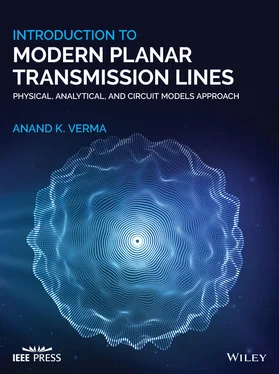1.3.1 The Organization of Chapters in This Book
The chapters of this book are organized into four distinct groups as follows:
1 Introductory transmission line and EM wave theory.
2 Basic planar lines and Resonators: Microstrip, CPW, Slot lines, Coupled lines, and Resonators.
3 Analytical Methods: Conformal mapping method, Variational method, Full‐ wave SDA, and SLR formulation.
4 Contemporary engineered planar structures: Periodic planar lines and surfaces, Metamaterials – Bulk, 1D metalines, 2D metasurfaces.
The group i reviews the transmission line and the EM‐theory to assist the reader to follow the rest of the chapters with ease. The groups ii and iii form the classical transmission lines, and the group iv is the modern transmission lines and surfaces . The book presents a seamless treatment of the classical planar transmission lines and the modern engineered planar lines and surfaces using the concept of EBG and metamaterials. The modern EBG and metamaterials based planar lines are the outcome of the classical researches in the artificial dielectrics and concept of homogenization of mixing of inclusions in the host medium. The topics of the chapters are selected to provide comprehensive coverage of the needed background to understand the functioning of both the classical and modern lines and surfaces. Each chapter follows a uniform style. The topics within a chapter start with simple concepts and move to a higher complexity level. Likewise, the chapters are also arranged from the simpler to complex.
The distribution of the chapters among the groups is discussed below. The key features of the chapters are also summarized.
Introductory Transmission Line and EM‐Wave Theory
The six chapters, chapters 2– 7, on the transmission lines and various aspects of the EM‐theory are introduced in the book before even commencing with the microstrip in chapter 8. These topics provide the essential background to follow smoothly the topics covered in this book. It could be useful in understanding the analysis and modeling of the planar line structures, the EBG based lines, and surfaces, and also the metamaterials and metasurfaces. Moreover, the topics discussed may also help to understand the modern publications in these fields. The usual undergraduate textbooks on the EM‐theory do not cover all the topics. However, the reader's familiarity with the transmission line and EM‐theory is assumed. The reader interested in a more detailed study of these topics can follow the references given at the end of the chapters. Some contents of the chapters are highlighted below.
The chapters 2and 3on transmission lines are written as a review. However, it goes beyond a regular review, although it starts with the familiar notion of oscillation and wave propagation on lines. Usually, the available textbooks present the transmission line equations and wave equations for the uniform lines only, without any source. The present book covers the transmission line equations and wave equations with a source, and the analysis of the multisection transmission lines is also introduced. Such formulation is used in the chapters 14and 16to obtain the Green's functions of planar transmission lines used with the variational method and full‐wave spectral‐domain analysis (SDA) method. The chapter on the transmission line adequately covers the concept of dispersion in the wave supporting medium. Also, the impact of the reactive loading of the line on the nature of wave propagation is discussed. Such treatment prepares a reader for the periodically loaded engineered lines and surfaces, both as the bandgap medium and homogenized metamaterial medium. These topics are discussed in chapters 19– 22. Chapter 3covers various parameters used for the characterization of a line section. Understanding of this topic is essential for understanding the microwave components design, the results obtained from EM‐simulation, and to develop the circuit models.
Chapters 4and 5cover the wave's propagation in the material medium. Again, primarily it is a review of the EM‐theory. However, its perspective is very broadly applicable to the topics discussed in other chapters. The chapter 4commences with a basic review of the electromagnetics and elementary electrical properties of the material medium, such as linearity, nonlinearity, homogeneity, inhomogeneity, anisotropy, and losses. It further covers the topic of the circuit modeling of a medium. The known topics of Maxwell's equations in the differential form, as well as in the vector‐algebraic form are presented. The wave propagation is discussed not only in the isotropic and conducting media but also in the anisotropic, uniaxial, gyroelectric , and biaxial media. The complex media are encountered by the wave propagating in the metamaterials. While reviewing the wave polarizations, the Jones matrix description of polarization states is also discussed. It is needed to follow the contemporary developments in the metasurfaces. Chapter 4ends with the concepts of isofrequency contours and isofrequency surfaces , and the dispersion relations in the uniaxial medium.
Chapter 5reviews both the normal and polarization‐dependent oblique incidence of the waves at the interface of two media. It also presents the equivalent transmission line model of the wave's incidence at the interface of two media. The model can be extended to more number of layers. The formulation has many applications. The model is used for instance in chapter 20on the EBG surface. The chapter 5also presents the basic electrodynamics of the engineered metamaterials and formulate the basic characteristics of the wave propagation in the metamaterials. It also discusses some important directions for applications of metamaterials. However, the realization of the bulk metamaterials, metalines, and metasurfaces are followed up in the chapters 21and 22.
Chapter 6covers a review of the electrical properties of the natural and artificial dielectric media. It also presents various static and frequency‐dependent models of the mixture media. The artificial dielectric medium finds its application in modeling the metamaterials. The Lorentz, Drude, and Debye models applicable to the frequency‐dependent permittivity are discussed. Chapter 6further discusses the interfacial polarization and its circuit model. This important topic is usually not discussed in popular textbooks. The modeling of the substrates, using the single term Debye and Lorentz models, as well as the multi‐term and wideband Debye models are elaborated. These models help to get the causal effective permittivity of the planar lines of the substrates, useful in the time‐domain analysis of pulse propagation on the planar lines. Finally, the chapter ends with a novel concept of artificial metasubstrate.
Chapter 7comprehensively treats basic waveguide structures. It begins with the classification of the modal EM‐fields, and the sources of their generation. The waveguides are analyzed using the scalar electric and magnetic potentials. The spectral domain analysis (SDA) method discussed in chapter 16is based on these scalar potentials. The concept of the perfect electric conductor (PEC) and the perfect magnetic conductor (PMC) with boundary conditions are introduced. The analysis of the rectangular geometry of the waveguides formed with these surfaces is presented. Thus, apart from the usual all metallic walls, i.e. the PEC based waveguides, all PMC and two PEC and two PMC walls waveguides are also discussed. The dielectric slab waveguides and surface‐waveguides are also presented. The concept of the odd/even mode analysis is introduced. These concepts are used in the book for the analysis of symmetrically coupled planar lines in chapters 11and 12. The simple and powerful transverse resonance method (TRM) is introduced to get the propagation characteristics of the dielectric‐loaded waveguides and the multilayer surface‐waveguides. Finally, chapter 7ends with the contemporary substrate integrated waveguide (SIW) developed in the environment of the planar technology.
Читать дальше












